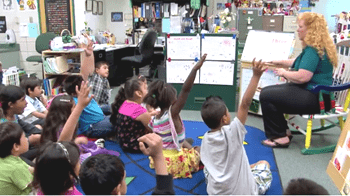School can be tough, especially if a child doesn’t understand the academic language being used in the classroom and on tests, causing the child to have feelings of anxiety, self-doubt, and embarrassment. These feelings can interfere with the child’s learning process.
According to Stephen Krashen – linguist, educational researcher, and activist – these negative emotional responses to one’s environment can cause an impediment to learning or language acquisition, which he refers to as the
Affective Filter. He believes “learning is seen to be heavily dependent on the mood of the learner, with learning being impaired if the learner is under stress or does not want to learn the language.” If the leaner is feeling nervous, embarrassed, or any of these other negative emotions, the affective filter is “up”. So how can educators and parents lower the affective filter in the classroom and at home to promote literacy and learning?
Krashen suggests lowering the affective filter “by sparking interest, providing low-anxiety environments, and bolstering the learner’s self-esteem.” The GrapeSEED program was developed with this type of positive environment in mind. The idea is to make children feel safe, relaxed, and encouraged as they listen and begin to speak Standard English. This is done using the
Gradual Release of Responsibility: first the teacher models the sounds and words of the activity, then the children participate in the activity together with the teacher, and finally the children become independent and perform the activity on their own, without the help of the teacher. And with a wide variety of materials, including Songs, Poems, Stories, Action Activities and more, the children stay interested and have fun as they acquire the language.
Repeated Exposure and Practice (REP) materials are provided for each student to share and practice at home with their parents. The books, DVDs, and CDs are fun and interactive, providing an easy and nonthreatening way for parents to participate in their child’s learning.

These same ideas that are used in the GrapeSEED program can be used in any classroom or home. Lower the affective filter: make learning a positive experience and create a low-stress, supportive environment. Encourage others to support the learner as well. Use humor to make learning fun, and change up activities to keep it interesting. Model the behavior that you want your child or students to demonstrate, invite them to join you when they are ready, and remember to praise them when they succeed. Soon they will be ready to do it all on their own, and you’ll be amazed at the confidence they build up along the way!





